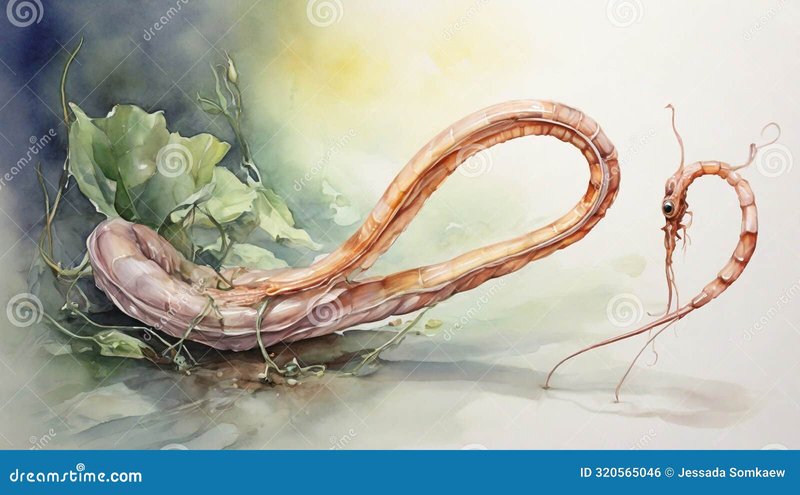
So, what exactly is a ribbon worm, and how does this proboscis work? Let’s break it down together, and I promise it’ll be more fascinating than you might expect. Imagine you’re at a buffet, trying to grab your favorite food without anyone noticing. That’s a bit like what these worms do underwater when they’re hunting for smaller creatures.
Understanding Ribbon Worms
Ribbon worms belong to the phylum Nemertea, which makes them quite different from your garden-variety earthworms. These creatures come in a variety of sizes—from a few centimeters to several meters long! They’re often found in marine environments, burrowing into the soft substrate or gliding through the water.
What sets them apart is their unique body structure. Ribbon worms are long and slender, resembling ribbons or noodles. But it’s their **proboscis** that really makes them special. This organ is a long, tube-like structure that can extend dramatically, allowing them to reach prey that is just out of grasp. If you’re thinking about how a chameleon’s tongue darts out to catch insects, you’re on the right track!
The Anatomy of the Proboscis
So, what exactly does this proboscis look like? Visually, it’s a long, fleshy tube that can be coiled up inside the worm’s body. When the worm is ready to hunt, this organ rapidly unfurls and extends, often several times the length of the worm itself. It’s like having a secret compartment that can shoot out a tentacle!
Now, the proboscis isn’t just for show. It’s lined with tiny, sticky structures called **rhabdite cells**. These cells help capture prey by sticking to them when the proboscis strikes. Think of it as a sticky glove that grabs onto whatever the worm targets—be it a shrimp, small fish, or even other worms. This sticky mechanism is crucial for a successful catch, ensuring that their meal doesn’t escape once it’s caught.
How Ribbon Worms Capture Prey
The actual process of capturing prey is like a well-rehearsed performance. First, the ribbon worm detects movement in its surroundings using sensory organs. When it spots something worth eating, it’s showtime: the proboscis shoots out, grabbing hold of the unsuspecting prey.
With this swift strike, the sticky rhabdite cells cling to the prey. This is almost instantaneous, and it’s one of those jaw-dropping moments in the animal kingdom. After securing its meal, the worm can draw the prey back toward its mouth, ready to enjoy its meal. If you think about it, it’s a bit like a fisherman casting out a line and reeling in a big catch!
The Role of the Proboscis in Feeding
Once the prey is captured, the ribbon worm doesn’t just munch away. Instead, it often injects a toxin or digestive enzymes through the proboscis to subdue the prey. Here’s the thing: this strategy not only immobilizes the victim but also begins the digestion process. By the time the worm pulls the meal closer, it’s already partially digested—talk about multitasking!
This method of feeding makes ribbon worms highly efficient predators. They can use their proboscis to take down prey much larger than themselves. If you’ve ever seen a magician pull a rabbit out of a hat, you know that sometimes, the best tricks come from the most surprising places.
Ecological Importance of Ribbon Worms
Ribbon worms might not be the flashiest creatures in the ocean, but they play a vital role in their ecosystems. They help maintain the balance of marine food webs by preying on small invertebrates and contributing to the nutrient cycle. When they feast, they help control populations of other marine organisms, ensuring that no single species takes over.
Additionally, ribbon worms are food for various predators, including fish and birds. So, in a way, they’re part of a larger story—a web of life where every creature has a role to play, much like the intricate connections we share in our own communities.
Challenges Facing Ribbon Worms
Like many species, ribbon worms face challenges in their environments. Pollution, habitat destruction, and climate change can impact their populations. As their habitats are threatened, the delicate balance they help maintain can be disrupted.
These challenges emphasize the importance of conservation efforts to protect marine ecosystems. By understanding the role of ribbon worms and other species, we can better appreciate the rich tapestry of life in our oceans.
So there you have it! Ribbon worms and their remarkable proboscis are a captivating topic that highlights the wonders of nature. From their unique feeding strategies to their role in marine ecosystems, these creatures remind us that there’s so much more to life beneath the waves than we might imagine.
Next time you think about the ocean, picture these ribbon-like hunters using their secret weapon, the proboscis. It’s a small but mighty part of the natural world, showing just how clever and adaptable life can be, even in the depths of the sea.

